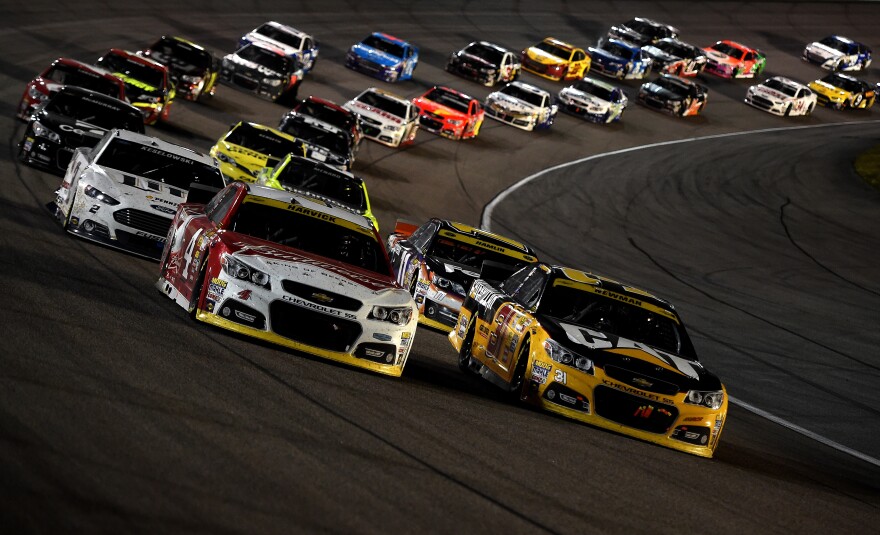The green flag drops on the NASCAR season this Sunday, with the Daytona 500. NASCAR enters its new year with a giant TV contract and a revamped playoff system that led to wrecks, fights and some higher ratings last year.
But the sport is still nowhere near as well-viewed or attended as it was before the recession.
NASCAR's new playoff system came down to drivers Kevin Harvick and Ryan Newman, racing neck and neck last November. Harvick held off Newman over the final few laps of the final race of the year to win the championship.
Playoffs normally end this way: Whoever wins the final contest wins it all. But before last year, NASCAR's postseason was nothing like other sports.
"The strategy before used to always be consistency," says Gene Haas, co-owner of Harvick's racing team.
NASCAR calls its playoffs " the Chase." The Chase used to be a convoluted point system where it didn't matter if you won races as long as you finished in the top 10 pretty often.
Last season, NASCAR became more like other sports, with knockout rounds and a winner-take-all championship.
"The strategy now is win — win at all costs — because that's what moves you up and then there's a lot of Hail Mary passes," Haas says.
In stock car racing, "Hail Marys" sometimes mean wrecks, and then, fistfights.
Jeff Gordon, Brad Keselowski and their pit crews were in an all-out brawl in Texas in November, with both drivers getting a little bloody. When the fight started, the crowd went wild — and TV ratings for the next race spiked.
In fact, more people watched several of the playoff races, including the championship, than had in years, according to Sports Media Watch.
Gordon, a four-time champion who is retiring after the upcoming season, says the changes are working.
"We had to reinvent ourselves, and the Chase format last year was phenomenal," Gordon says. "And I think that that really kind of got the buzz back."
But even though more people turned on the TV for the final Chase races, viewership for NASCAR's playoffs overall was down slightly from the year before.
Attendance continues to be a challenge, too. The Atlanta Motor Speedway is tearing out 17,000 seats — and it's not the only one. At the Charlotte Motor Speedway, there is a gaping hole where an entire section of stands used to be. Construction crews are getting rid of 41,000 seats.
To put that in perspective, if you took that many seats out of most NFL stadiums, you'd be cutting their seating capacity in half.
This is a business adjusting to its post-recession reality. Admissions revenue at the major tracks is down steeply from their peaks in 2007 and 2008.

But Charlotte Speedway General Manager Marcus Smith says NASCAR may have turned the corner.
"We've seen the curb flatten, and now we're seeing it tick up a little bit," Smith says. "So as the economy improves and with gas prices lower, it really puts more money in people's pockets, and we're seeing that show up in the ticket office."
He says the speedway is ahead with ticket sales for the 2015 season.
And keep in mind, low attendance for NASCAR is still huge compared with many other sports. The Charlotte Speedway, for example, will still have room for roughly 90,000 people after it removes all those seats.
NASCAR CEO Brian France says the sport measures its success partly online now, too.
"[A b]illion downloads and millions of people every week, unique users on our site, so when you judge it all, this is not only the most dominant motor sport in North America by a wide margin," France says, but it's also competing well with other sports.
NBC and Fox Sports are combining to pay more than $8 billion for NASCAR TV rights over the next 10 years.
Fox Sports President Eric Shanks says because of changing trends in how people watch TV, sports are one of the few things people still watch live.
"Twenty years ago, no NASCAR race would've ranked in the top 20 prime-time shows. Now NASCAR is a top five prime-time show," Shanks says.
Copyright 2020 WFAE. To see more, visit WFAE. 9(MDAyNDY5ODMwMDEyMjg3NjMzMTE1ZjE2MA001))




